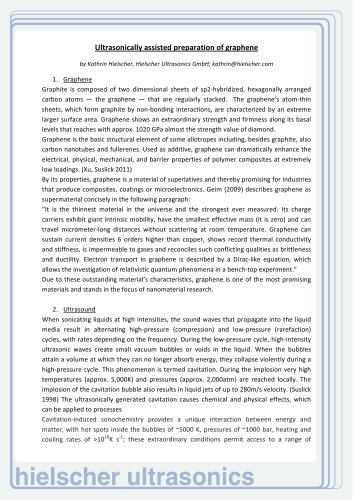 Website:
Hielscher
Website:
Hielscher
Catalog excerpts

Ultrasonic Production of Biodegradable Nanospheres Biodegradable micro- and nanospheres can be produced in a continuous, contact- and contamination-free process that can be readily run under sterile conditions. Introduction Biodegradable micro- and nanospheres (MS, NS) made of poly(lactide-coglycolide) (PLGA) or other materials are very potent drug and antigen delivery systems with inherent potential for drug and antigen targeting. Present methods to produce PLGA NS are typical batch processes and suffer from difficulties of upscaling under sterile conditions. Here, we present a novel and elegant method to produce PLGA NS in a continuous, contact- and contamination-free process that can be readily run under sterile conditions. During the entire manufacturing process, the product is in direct contact only with sterile glass and Teflon® tubes. The process can be run in a closed system to prevent any environmental contamination. Methods PLGA50:50 nanoparticles (Resomer® RG503H, Boehringer Ingelheim) were produced using a modified solvent extraction/evaporation process [1]. PLGA dissolved in dichloromethane (2 or 5%) was dispersed in aqueous 0.5% (w/w) PVA-solution by means of the novel experimental set-up involving a contact-free flow-through ultrasonication cell. The coarse O/W-dispersion was first premixed by a magnetic stirrer and then homogenized in the ultrasonic flow-through cell (flow rates of O- and W-phases were at 1:8). The initially formed PLGA-solvent nanodroplets gradually solidified during the passage in the tubes to become PLGA nanoparticles. Final hardening of the particles was achieved in a larger volume of 0.5% PVA solution. Fig. 1: Experimental set-up for the production of PLGA nanospheres
Open the catalog to page 1
Fig. 2: Design of ultrasonic flow-through cell Nanoparticles with a mean diameter of 485 nm were readily prepared from a 2% PLGA solution in DCM at 32W sonication power (Tab. 1). The size distribution was mono-modal with a slight tailing (Fig. 3A). Nanoparticle sizes extended from 175 to 755 nm according to the 10 and 90% percentiles. Repeatability of the production process was consistently good, as reflected by only minor variability in the mean particle diameter. Lowering the emulsion's residence time in the sonic field from 14 to 7s had only a minor impact on the nanoparticle size. A...
Open the catalog to page 2
Fig. 3: PLGA nanoparticles. (A): Size distribution of particles prepared at polymer concentration/ sonication power of 2%/ 32W, 5%/ 32W, and 2%/ 25W%; residence time = 14 s. (B),(C): SEM pictures of particles prepared from 2 and 5% polymer solutions, respectively. Residence time = 14s; sonication power = 32W. Bars represent 1 micron. Discussion and Conclusions The ultrasonic flow-through cell was found to be well suited for emulsion-solvent extraction/evaporation based production of biodegradable polymeric nanospheres. Future research will be directed towards scaling-up the process and...
Open the catalog to page 3All Hielscher catalogs and technical brochures
-
Ultrasonic Process Lab
1 Pages
-
Ultrasonic Wire Cleaning
4 Pages
-
Ultrasonic Applications
1 Pages
-
Hielscher Ultrasonic Sieves
2 Pages



















